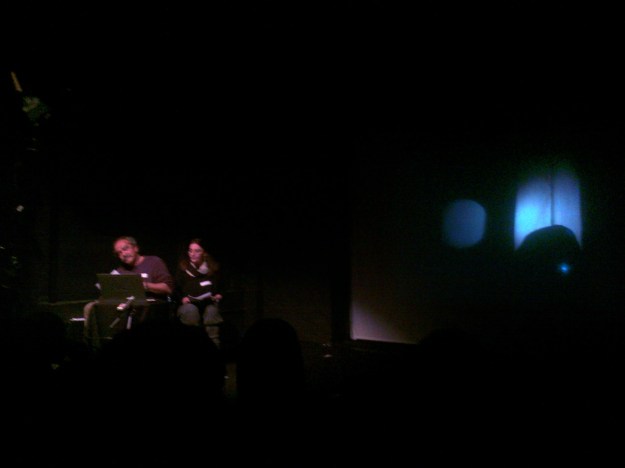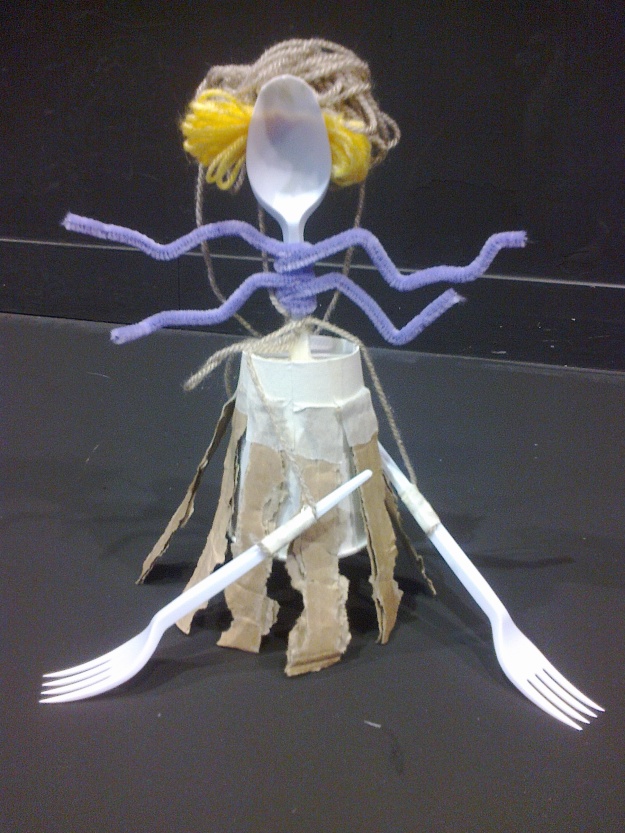A friend who has been making puppets and puppet shows professionally for over two decades recently told me, in so many words, that “I’ve never been that much into puppets. It’s the ideas beneath them which interest me.” And so it is that last weekend I spent two days with an eclectic bunch of people, from a wide range of countries, with a hugely diverse range of backgrounds, who were all united by one key thing – their use of, and interest in puppets as a tool for change. They call these people socially engaged artists, participatory artists – and they call their chosen field that of applied puppetry. There were PhD students, dramatherapists, primary school teachers and clinical psychologists; arty types, beatniks and itinerant street performers. And although some attendees might have been able to claim a lifelong interest in puppetry as an art form, I have a feeling that most, myself included, would describe themselves as people who ended up stumbling accidentally into using puppets to explore the themes most inextricably linked to human existence.
The first day of the symposium was spent in the semi darkness of the Little Angel Theatre’s auditorium, absorbing insights from a series of speakers who spoke about the different ways that they had used puppetry in socially engaged projects.
Helena Korosec, a former primary school teacher based in Slovenia, described a research project in which she integrated puppetry into teaching and learning processes within primary schools, allowing a puppet ‘character’ to become a core, familiar member of a class. Teachers were equipped with puppetry skills and primed to document any perceived changes in pro-social behaviour, social competence, concentration levels, etc. All test groups showed a marked improvement in all categories, including a decrease in aggressive behaviour.
Riku Laakkonen came from Finland to talk about his use of forum puppetry, a technique fusing Brazilian social activist and theatre practitioner Augusto Boal’s forum theatre with the use of puppets. He discussed how, whilst working with a group of individuals recuperating from mental illness, he used Boal’s theatre techniques to explore and interrogate participants’ autobiographical stories – but found that often individuals were reluctant to perform as themselves, due to the heaviness of the material. In substituting actors with puppets, the group was able to enter into the material beneath a veil of anonymity, and engage with it safely.
Two professers of education from the University of Athens came to talk about using puppetry (mainly shadow puppetry) to merge the sciences with the visual arts within education, in teacher training. Antigoni Paroussi and Vasilis Tselfes, professers in theatre and science respectively, spoke of the 8 years that they have spent investigating ways of ‘constructing scientific worlds using puppet theatre as a means’ – and showed some electifying performances created by their students, navigating scientific ideas through shadow puppetry and performance arts.
 Antigoni Paroussi and Vasilis Tselfes
Antigoni Paroussi and Vasilis Tselfes
The discussion of two projects based on collaborations between NHS therapists and puppetry specialists demonstrated the ongoing research into puppetry as a powerful therapeutic tool for people with mental health issues. Conclusions were still unclear – one group spoke of how the use of puppetry caused some participants’ mental state to improve, and others’ to decline – they talked about the powerful emotions unleashed by the characters that participants created, and the volatile state this left the group in. They also spoke of their disappointment when, during a discussion about what to do with the puppets made during the sessions, all participants agreed that they should be thrown away or destroyed. Having experienced the huge catharsis of burning my own puppet creation (see the Westcountry Storytelling Festival 2012 blog post!) I feel that if anything, this attitude might have indicated the success of the project – individuals wouldn’t have felt the need to destroy objects had they not come to carry pivotal and potent meanings.
Finally, two inspiring examples of puppetry being used to inject life into communities in far flung places:- firstly, Katie Francis and Sasha Nemeckova reccounted their tour of special needs schools in India, performing Rubbish, an interactive and sensory theatre piece involving puppets and set made from reclaimed materials (and making me wholeheartedly envious of their experience – see their blog here). And Frans Hakkemars and Joanna Oussoren presented a film showing the transformation of Feijenoord, a disadvantaged district of Rotterdam in Holland, through a project which turned a public green space into a regular hub of street performance, theatre and children’s art activities, heavily featuring puppetry. With an array of mobile theatres-on-wheels which would make Terry Gilliam weak at the knees, Hakkemars and Oussoren encouraged interaction and mutual learning within a formerly segregated community.
Kati Francis and Sasha Nemeckova
Day two of the symposium allowed attendees to immerse themselves more deeply in applied puppetry techniques, through workshops facilitated by practitioners using puppetry in varied social contexts. I joined the Puppetry and Performance Skills for Healthcare Settings group, led by Siobhan Clancy of Helium Arts, which delivers arts interventions for children within hospital settings. The group was introduced to the limitations and issues relating to using puppetry in hospital wards, and we were challenged to make puppets using extremely basic, limited materials, and with specific health issues or physical disabilities in mind (see my puppet attempt below). Later we absorbed a range of fascinating techniques and processes through which to begin to use these puppets to facilitate story, creativity and play. Siobhan introduced us to two excellent ‘story starters’ – a game called ‘Unfortunately/Fortunately’, in which characters spontaneously come up with lines of dialogue which begin ‘unfortunately’ or ‘fortunately’, and ‘Hours of the day’, in which characters describe what they would normally be doing at 8 o’clock, 9 o’clock, etc. At this point my puppet madame, in a sultry French accent, announced that at midday on a monday she might be at Heathrow airport waiting for a business flight, because her life is “soooo unpredictable and exciting…” Hmm.
Siobhan then gave us a range of processes (many of which she has borrowed from Augusto Boal’s range of community theatre techniques) and asked us to use one of them to develop short performances, in groups. The techniques she gave us were: Mind mapping (a fascinating creative tool but one which I’ve never used to produce a performance or story); Stop and Think (a Boal technique which brings out characters’ inner dialogue within a given situation); Hanover Interrogation (also known as Hot Seating, in which a character is removed from a story/situation and interviewed to discover more about their inner world); analytical rehearsal style (in which a story or performance is created within which all characters are symbols of an idea or concept); Rashoman (a Boal technique based on hugely exaggerated characters); and Long Beach Telegram (whereby a story or performance is created through one-word dialogue only. Our group went on to use mind mapping to generate the themes of memory, time and memory loss, then analytical rehearsal style to perform a short surreal piece about a picnic attended by the guests of time, memory and memory loss!
Thus ended two intense days spent with people from around the world, forming a small, temporary community of individuals intent on figuring out what it is about inanimate objects made to resemble living beings that holds such potency. We might not be so interested in the finer aspects of choreography and dramaturgy when it comes to puppetry, but we remain fascinated by the power of a puppet to help, heal and develop the human psyche.

